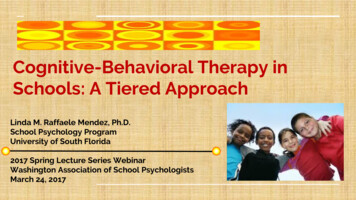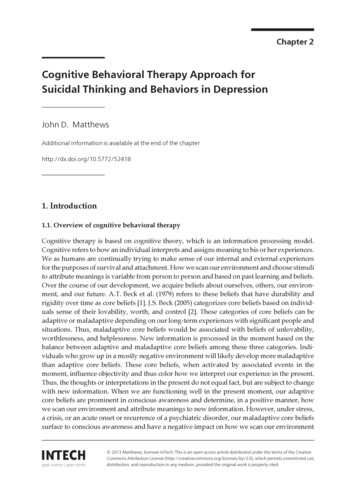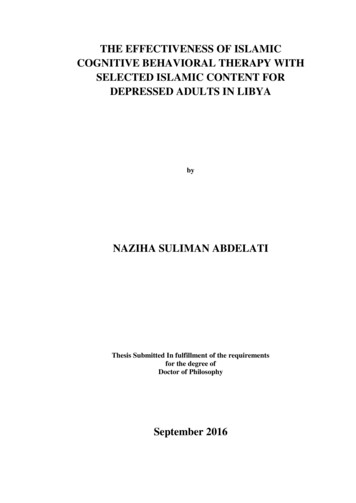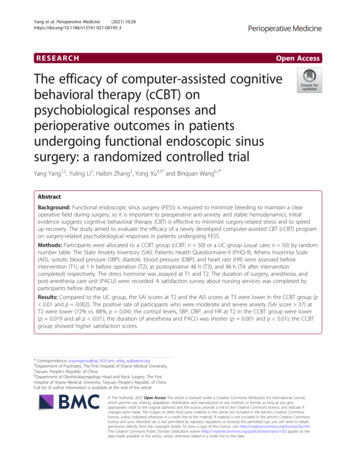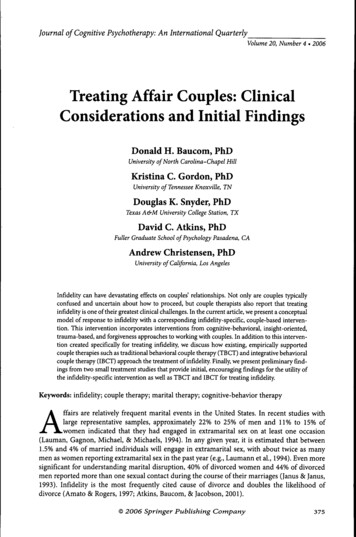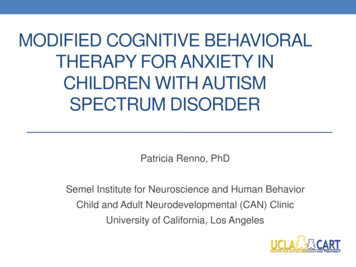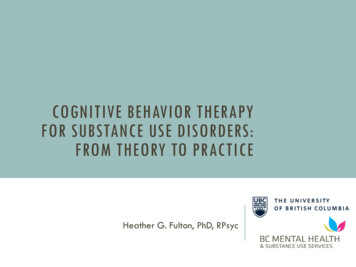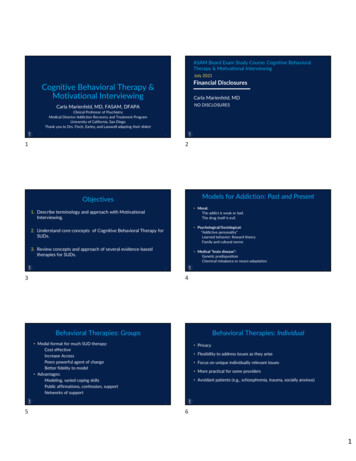
Transcription
ASAM Board Exam Study Course: Cognitive BehavioralTherapy & Motivational InterviewingJuly 2021Financial DisclosuresCarla Marienfeld, MDNO DISCLOSURESCarla Marienfeld, MD, FASAM, DFAPAClinical Professor of PsychiatryMedical Director Addiction Recovery and Treatment ProgramUniversity of California, San DiegoThank you to Drs. Finch, Earley, and Lasswell adapting their slides!1121. Describe terminology and approach with MotivationalInterviewing. Moral:The addict is weak or bad.The drug itself is evil.2. Understand core concepts of Cognitive Behavioral Therapy forSUDs. Psychological/Sociological:“Addictive personality”Learned behavior: Reward theoryFamily and cultural norms3. Review concepts and approach of several evidence‐basedtherapies for SUDs. Medical “brain disease”:Genetic predispositionChemical imbalance or neuro‐adaptation3344 Modal format for much SUD therapy:Cost effectiveIncrease AccessPeers powerful agent of changeBetter fidelity to model Advantages:Modeling, varied coping skillsPublic affirmations, confession, supportNetworks of support Privacy Flexibility to address issues as they arise Focus on unique individually relevant issues More practical for some providers Avoidant patients (e.g., schizophrenia, trauma, socially anxious)55661
Motivational Interviewing (MI)Cognitive‐Behavioral Treatment (CBT)Mutual Help (AA, NA, Smart Recovery, Women for Sobriety)Community Reinforcement Approach (CRA)Community Reinforcement And Family Therapy (CRAFT)Contingency Management (CM)Behavioral Couples TreatmentAcceptance and Commitment Therapy (ACT)Dialectical Behavioral Therapy (DBT)Supportive TherapyA. PalliationB. AcceptanceC. ComparisonD. Evolution7788DirectingGuidingFollowing“MI is about arranging conversations so that peopletalk themselves into change based on their values andinterests.” TeachAssessPrescribeLead Draw out Encourage Motivate Listen Understand Go along withMiller and Rollnick, Motivational Interviewing:Helping People Change, 3rd Edition, 2013.Miller and Rollnick, Motivational Interviewing:Helping People Change, 3rd Edition, 2013.991010Emphasis on spirit rather than techniques.Partnership Acceptance Compassion Evocation Miller and Rollnick, MotivationalInterviewing: Helping People Change, 3rdEdition, 2013.Source of metaphor: Jeff Allison111112122
A. Engaging the patient in the processB. Fantasizing about a better future for yourselfC. Eliciting change talk from the patient.D. Perseverating on the change the patient wishes toPlanning (how will we get there?)Evoking (why are we going there?)Focusing (where shall we go?)make for themselves.Engaging (shall we walk together?)13131414 Open Ended Questions“Right now, drinking doesn’t help me feel better the way itused to. In fact, I feel worse now.” Affirming Echo: Drinking makes you feel worse now. Reflecting (simple and complex) Rephrase: So you find that drinking is no longer helping you to feelbetter, the way it used to. Summarizing Double‐sided: In the past, drinking helped you to feel better. Nowit makes matters worse. Informing & Advising (with permission, elicit‐provide‐elicit) Continuation: and you want to find some way to feel betterinstead of drinking.Miller and Rollnick, Motivational Interviewing:Helping People Change, 3rd Edition, 2013.15151616 Change talk: as a person argues on behalf ofone position, he or she becomes morecommitted to it; we talk ourselves into (or outof) things.DARN CAT Sustain talk: the more of it is evoked during acounseling session, the more likely that theperson will continue the status quo.Want tochangeCOMMITMENT LANGUAGE PREDICTS CHANGE C: commitment — Will, intend to, going to A: activation — Ready to, willing to (w/o specific commitment) T: taking steps — Report recent specific action toward changeDon'twant tochange1717D: desire ‐‐ Want, wish, likeA: ability ‐‐ Can, could, ableR: reason ‐‐ Specific reason for changeN: need ‐‐ Need to, have to, must, important18183
From the founders: “[MET] is a systematic intervention approach forevoking change in problem drinkers. It is based on principles ofmotivational psychology and is designed to produce rapid, internallymotivated change. This treatment strategy does not attempt to guide andtrain the client, step by step, through recovery, but instead employsmotivational strategies to mobilize the client’s own change resources.”– Miller et al., 1999A. Eliciting change talk from the patientB. Earning vouchers for negative urine drug screensC. Targeting cognitive, affective, and situational triggersAdapted from Motivational Interviewing4 session protocol – great for short‐term therapeutic relationshipsUsed as a tailored approach for substance misusersThree phasesManual available here: https://casaa.unm.edu/download/MET.pdffor substance useD. Conducting a moral inventory19192020 CBT models among the most extensively evaluated interventions for SUDsBased primarily on Marlatt and Gordon's 1985 model of relapseprevention target cognitive, affective, and situational triggers for substance useprovide skills training specific to coping alternatives CBT says: Substance use is reinforcing,this interacts with psychological orbehavioral coping deficits to produceincrease in substance useSUD develops when pattern is repeatedSolution: more effective copingAlso deals with expectanciesStages of treatment: Building rapport and alliance Preparing for Change CBT Strategies Maintaining Change/Termination f21212222 Identification of high risk situations“people, places, and things”1. Recognize:triggers‐cues: external‐internal2. Anticipate/Avoid:high risk situations‐people‐places3. Cope:skills for relaxing‐dealing with stress‐dysphoria4. Connect:options for support‐socializing‐fun‐meaning Development of coping skillsTo manage risk/triggers as well as negative emotional states Development of new lifestyle behaviorsTo decrease need for/role of substance use Development of sense of self‐efficacyBuild on small successes in coping232324244
Communication skillsRefusal skillsAsking for help Preparation for lapsesProcess to be learned from “lapses”Prevent lapse from becoming relapseIdentify and manage patterns of thinking that increase risk Dealing with relapseRelapse is not a catastropheMinimize consequences From the founders: “This therapy is grounded in the concept ofalcoholism as a spiritual and medical disease. The content of thisintervention is consistent with the 12 Steps of AlcoholicsAnonymous (AA), with primary emphasis given to Steps 1 though 5.In addition to abstinence from alcohol, a major goal of the treatmentis to foster the patient’s commitment to participation in AA.”‐ Nowinski, Baker, & Carroll, 1999Emphasizes concepts like acceptance, surrender, the moral inventoryCovers strategies like HALTIncludes sessions for family members covering enabling anddetachingAvailable here: ch/match01.pdf25252626 Both are evidence supported behavioral treatments for SUD Community Reinforcement Approach (CRA) Based on operant conditioning: substance use as learned behaviorIntended for the person Naturalistic: uses contingencies already operating in theindividual’s natural environment to support change and abstinence(e.g., giving or withholding praise for behaviors)Based on the belief that a drinker’s “community” (e.g., family, social and jobenvironment) plays a critical role in supporting or discouraging useConsequently the environment needs to be restructured such that a soberlifestyle is more rewarding than a using lifestyle Community Reinforcement and Family Therapy (CRAFT) Functional analysis of both healthy and substance use behaviors interms of ability to reward/be aversiveAn outgrowth of CRAHelps the family Method for working with concerned family members in order to get atreatment‐refusing person to enter treatment Refining problem‐solving and goal‐setting efforts for individualand/or family (teaching positive communication, contracting skills)27272828 From the founder: “The Community Reinforcement Approach and FamilyTraining (CRAFT) intervention is a scientifically based intervention designed tohelp concerned significant others (CSOs) to engage treatment‐refusing substanceabusers into treatment.”‐ Robert J. Meyers, 2019 Goal: treatment engagement for the substance user“Positive approach” that avoids confrontationCulturally sensitive: works with cultural mores/beliefs to develop treatment planTeaches CSOs to use positive reinforcers (rewards)Encourages CSOs to allow the substance user to suffer natural consequences ofusing behavior Includes: functional analysis, sobriety sampling, CRA treatment plan, behavioralskills training, job skills, social/rec counseling, relapse prevention, andrelationship counseling 2929Uses therapeutically applied incentives and other reinforcements toincrease one or more target behaviorsVariety of reinforcement schedules, contingency types, and variationsStandard treatment includes twelve weeks of CMAdjunct to on‐going therapy or stand‐aloneCan be implemented by case managers to trained specialistsClinical trials indicate: Increase attendance in programming Medication adherence Drug abstinence Helps stimulant use disorder; adolescents30305
From the founders: “BCT tries to increase and reward behaviors that supportabstinence and long‐term recovery.”‐ Fals‐Stewart, O’Farrell, Birchler, & Gorman, C. (2006) Based on operant conditioning: substance use as learned behavior Uses contingencies set in place explicitly and exclusively for therapeutic Stand alone or in concert with another treatment 12 sessions Support for Recovery Relationship Enhancement Communication Skills Continuing Recovery Skills include: Establishing shared goals, catching partner(s) doing somethingnice, share rewarding activities, employing problem‐solving, generating an actionplan for moving forwardpurposes Examples Earning vouchers exchangeable for retail products contingent onnegative urine toxicology results Earning methadone take‐home privileges for negative urine drugscreens31313232 Has been studied for use with SUDs, but not widely Six Core Processes Acceptance Cognitive Diffusion Being Present Self As Context Values Committed Action Manual driven behavioral treatment utilizing validation and motivationalenhancement techniques Often combination of group and individual elements Addresses enhancement of four basic capabilities:Interpersonal effectivenessEmotional and self regulation capacitiesAbility to tolerate distressMindfulness Useful in helping pts consider how their substance use disconnects themfrom their values/comparing “sober values” to “using values”/reconnecting tovalues33333434 Basic Elements of Psychotherapy:From the founder: “When DBT is successful, the patient learns to envision,articulate, pursue, and sustain goals that are independent of his or her history of out‐of‐control behavior, including substance abuse, and is better able to grapple withlife’s ordinary problems.”‐ Linehan, 2008 Expectation of receiving help Therapeutic relationship Obtaining externalperspective/support Encouraging positive choices Frame of understandingCore processes: Change & acceptanceEmphasis on abstinence Change: pushing for immediate and permanent cessation of drug abuse Acceptance: a relapse, should it occur, does not mean that the patient or thetherapy cannot achieve the desired resultKey skills: Cope ahead, Failing wellAddict Mind Clean MindAll available in the medical encounter.3535Supportive PsychotherapyUses direct measures to ameliorate symptoms‐ to maintain, restore, or improve self‐esteem,ego functions, and adaptive skills.Focuses on developing adaptive capacitiesTake into account the patient’s limitations Deficits in character structureDefense mechanismsNative abilityLife circumstances36366
Monitor not just in terms of sobriety/abstinence Monitor in terms of functional (Don’t rely entirely on self‐report)‐occupational‐legal Is there progress toward patient’s identified goals? Is there active participation in treatment? Increase level of care Improve recovery environment Joblessness / Homelessness Substance users in living environment Assess and access treatment for co‐morbid psych problems Increase skills for tolerating negative affects Is there now a need for medication treatment?37373838 General guidelines Concurrent treatment post‐stabilization is best! Many effective, evidence‐based psychotherapy techniques Can be done in many settings Form the core of treatment for addictionsPTSD Cognitive Processing Therapy (CPT) Eye Movement Desensitization and Reprocessing (EMDR) Prolonged Exposure (PE) Concurrent Treatment of PTSD and SUDs using ProlongedExposure3939404041417
ASAM Board Exam Study Course: Cognitive Behavioral Therapy & Motivational Interviewing Carla Marienfeld, MD July 2021 NO DISCLOSURES Financial Disclosures 1. Describe terminology and approach with Motivational Interviewing. 2. Understand core concepts of Cognitive Behavioral Therapy for SUDs. 3.
